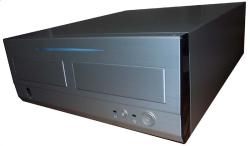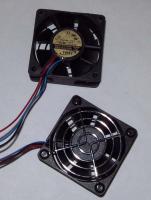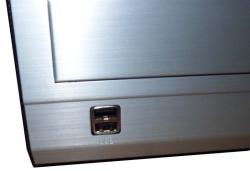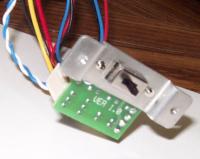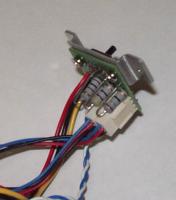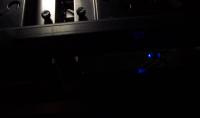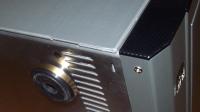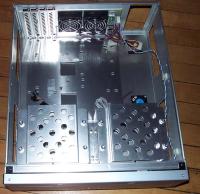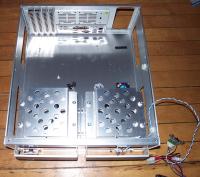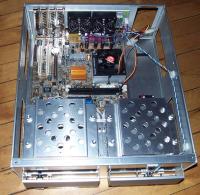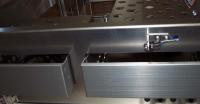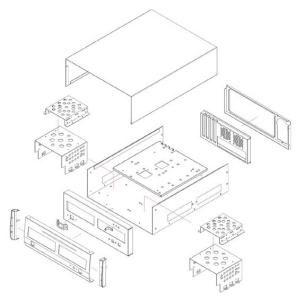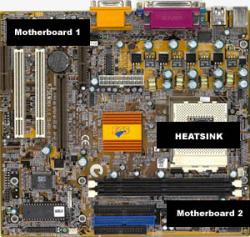
Original Link: https://www.anandtech.com/show/1043
PC-9300 Aluminum: Lian Li Enters the Small Form Factor Race
by Kristopher Kubicki on December 2, 2002 3:49 AM EST- Posted in
- Cases/Cooling/PSUs
Introduction
| Quick Look |
|
| Lian Li PC-9300 Aluminum |
The Good |
| + 1.0mm Aluminum Chassis |
|
| The Bad |
|
| - Small Form Factor |
|
Ever since their explosion onto the PC case market, Lian Li has made a name for themselves as a top of the line, "accept nothing less" brand name. Three years ago, they were one of the pioneers to bring aluminum cases to the US. Since then we have seen many companies follow suit to bring similarly designed cases to Western markets including Kingwin and Directron.
To distinguish themselves not only as a market leader in the aluminum PC case market, but also an innovator, Lian Li has switched things up a bit with their new case design, the PC-9300. As Shuttle (with the help of AMS) continues to dominate the very small form factor market virtually uncontested, the market has been eager to see another small PC case offering.
Construction
The first impression we got from the PC-9300 was that the case looked like nothing we have ever seen before, yet at the same time strikingly familiar. As expected with any Lian Li case, the chassis was constructed of 1.0mm brushed aluminum. Although no different than any other material on the market right now, the aluminum does scratch easily when another sharp surface makes contact.
We have done some extensive tests on aluminum cases in the past and apparently the advantages in cooling are minimal. The lightweight of the entire chassis makes this case a desirable enclosure for the LAN party enthusiast. Cooler Master's ATC-610 and Shuttle/AMS are no longer the only players in this niche market.
Anyone who has worked on a desktop PC in the 90's remembers the hassle of removing the covers on horizontal PC cases. Usually, the case cover had to slide back a few inches, and then the cover was pulled upwards to remove it from the case. Some of these cases required you to warp the cover just a fraction of an inch to completely separate it from the case; woe, the agony. Well, unfortunately, the PC-9300 is no different. To add insult to injury, the instruction manual for removing the case cover was found inside the case.
Furthermore, Lian Li neglected two inner edges underneath the cover. The two edges are not very sharp, but a little bit of carelessness will result in an awakening pinch. As we have stressed before, there is no excuse for sharp edges in an aftermarket PC case, especially in an area that needs to be touched often.
The case came with only 2 exhaust fans, which somewhat puzzled us. Since it is a small unit however, the negative pressure should not affect cooling performance much. Perhaps some small intake holes or an additional fan would go a long way to improve the airflow in this case. There is no airflow flowing past the drive bays.
The PC-9300 takes up a super small footprint of only 360mm x 132mm x 430mm (WHD), but uses the microATX rather than VIA's extremely small mini-ITX form factor.
Breakdown
|
Features
The small design of the PC-9300 may be its most significant feature. The case already has one strike against it for violating the "aftermarket no-sharp edges" rule, so it's a good thing the case has more to offer than just its unique size.
Almost every quality case these days has forward USB ports. The PC-9300 is no exception. Two small, no frills forward adaptors are present in the lower corner of the unit and are easily accessible. Almost everything on the case is removable by thumbscrews, which we have also come to accept as the standard for high end cases. Even the individual internal drive bays are each removable by thumbscrews.
The manual rear fan control was somewhat of a surprise to us. We did not see this feature advertised even though most other case companies are making a big deal of it on their cases. The rear control connects to any of the internal fans and provides 3 levels of intensity. We still think a good thermal resistor based solution beats manual control, but some people enjoy the degree of management the manual control provides.
Other nice touches were provided by Lian Li as well; front panel blue LED strip, mountable plastic clips on the inside of the case, and pre-glued aluminum plates to place over CD and DVD drives. All of these were nice touches and demonstrated the quality of the case we were dealing with.
Just when we thought Lian Li was able to get it all right, we saw the removable motherboard tray. Unfortunately, this tray is hardly removable at all. Four screws hold the bottom of this tray in, and the only way to remove the tray is to push the tray to the rear of the case and pull up. The problem with this process is two fold. First all the PCI/AGP cards must be removed to remove the motherboard. Second, the fans on the back of the case must also be removed in order to give the tray enough clearance to be pulled out completely. This hurt our opinion about the case drastically.
Uniquely Small
Since the PC-9300 is so small, the MicroATX form factor is the only form factor capable of fitting in such an enclosure. Compared to other small form factors, including VIA's mini-ITX and Shuttle's SFF, the microATX factor is fairly large. Unfortunately, that is demonstrated by the PC-9300, as it is a little wider than any of the SFF Shuttle systems. At Comdex, we got a brief look at VIA's newer mini-ITX boards which are smaller than both microATX and SFF. Unfortunately, the drawback of these mini-ITX boards is that they only accept C3 processors.
Previously noted were the 4 expansion bays, 2 external, 2 internal. This really does not leave much room for expansion. If you plan on using a floppy drive, one of the 5.25" external bays must be converted using the included bay mount. Unfortunately, this only leaves room for one DVD or CD-RW drive. Upgraded versions of the PC-9300 (which we saw at Comdex) have more room for expansion.
The main difference in using the PC-9300 compared to other cases is the micro-ATX, or SFX, power supply unit (PSU). Most SFX power supplies are only capable of 200W or less. This prohibits the use of demanding hardware. Most new cases do not typically ship with power supplies and the Lian Li PC-9300 continues this trend. Since SFX and microATX PSU's are harder to find, we would have liked to have seen this case ship with one. This is stressed particularly because there are multiple types of microATX supplies, and if Lian Li sent us a PSU with the case, the doubt of which unit to buy would be removed.
Benchmark
Typically, we use hardware capable of generating the most heat for our benchmarks. However, our ASUS AV7333, which we have used in other reviews does not fit in the Lian Li PC-9300. Furthermore, our extra hot Seagate Cheetah was unable to fit in either of the 3.5" drive bays on case either, so it was substituted with a single bayed drive.
All temperature is recorded in degrees Celsius. The heat tests were each performed inside the closed case with the external temperature of 23.0 degrees Celsius, during a full system load. Our testbed consists of:
|
Video is integrated in the K7SEM, but we used our GeForce4 just to give a good impression of heating performance. The thermal readings for the different components during operation were as followed:
Lian Li PC-9300
| CPU |
Video |
Heatsink |
Mobo 1 |
Mobo 2 |
HD |
|
| After 10 minutes |
41.0 |
38.1 |
31.0 |
32.5 |
30.0 |
30.0 |
| After 30 minutes |
47.0 |
39.7 |
34.7 |
35.0 |
33.0 |
34.5 |
Kingwin KT-436-WM
| CPU |
Video |
Heatsink |
Mobo 1 |
Mobo 2 |
HD |
|
| After 10 minutes |
54.0 |
32.5 |
38.0 |
25.0 |
28.5 |
27.2 |
| After 30 minutes |
54.5 |
33.3 |
38.9 |
26.1 |
29.0 |
28.6 |
For the most part, the components of the PC-9300 operated at a much higher temperature than other cases we have looked at. This is directly attributed to the low exhaust, nonexistent intake and general poor airflow. Remember, we are using much cooler hardware in the PC-9300 than in the Kingwin case. Using hotter hardware would result in unstable and possibly damaging conditions.
Sound is recorded in decibels from 12" away from the closed case to most accurately replicate a production system.
| dBA |
|
| Lian Li PC-9300 Aluminum |
41 |
| Kingwin 436-BK-WM Aluminum |
50 |
| ThermalTake Xaser II Aluminum Fan Low |
54 |
It has to be noted that the
Lian Li PC-9300 was running a significantly slower system than the AMD MP
2100+ system benchmarked for the other two systems. Furthermore, since the
PC-9300 had a much smaller form factor, a different PSU was necessary. With
only one fan, this PSU is a much quieter experience. The poor cooling on
even an XP 1800+ system is somewhat discouraging, but users planning on using
slower and cooler hardware will have no problems with this case.
Conclusions
There were a lot of interesting features on the PC-9300. A unique mix of the old and the new, this case gave us good dose of headaches and smiles. The removable components were very disappointing. We mentioned earlier that the motherboard tray was removable, but once unscrewed, almost impossible to get out of the case. The case cover also had several sharp edges and provided a nostalgic, yet annoying, experience when removing.
With those two severe strikes in mind, the PC-9300 had a lot to make up for. Fortunately, since we have only seen a few cases like the PC-9300 before, Lian Li finds dozens of opportunities to do so. Lian Li went the extra mile on almost every detail of the case, from the carbon fiber trim to the blue LED bar on top. As we mentioned earlier, the PC-9300 looked more like a piece of stereo equipment than a computer.
There are two apparent markets for this case. The first category being the DIY (do it yourself) population looking to play DiVX, MP3's, etc on an entertainment center. With a little bit of elbow grease and the right hardware, the PC-9300 makes a good starting point for a DIY Audiotron.
The second market for this case is the LAN party enthusiast. Shuttle went a long way to innovate this market with their cases and computers, and Lian Li would like to do the same. The lightweight, sleek design and small footprint really give the PC-9300 the style edge over a bulky Chenming variant case. Unfortunately, without the ability to put a large PSU over 200W in this case, do not expect to bring a new power-hungry P4 3.06GHz to that LAN party.
The lack of drive bays and PSU restrictions make this case somewhat unattractive for everyday use. Performance-wise, the PC-9300 performed well, but keep in mind the hardware we used was much smaller and cooler than previous benchmarks. The largest performance advantage was the low noise emission, which we can account for by its two exhaust fans. Of course, the major drawback of this is that the system runs a little hot.
Possibly you fit into one of the two markets we deem this case desirable for. The small form factor and light weight could be perfect for some other application you know of. As a highly specific case, in our opinion the PC-9300 is going to best appeal to the buyer with a lot of creativity.
The case retails for about 150USD, which is a little steep for a small form factor case for most people. Even though the PC-9300 is smaller then the Cooler Master ATC-610, it does not quite demonstrate the same maturity. As we saw at Comdex, Lian Li has two more small form factored cases should be hitting the market soon. If all goes well, according to Lian Li, the new offerings that should be hitting the mainstream market very soon.
A special thanks goes to Xoxide.com for providing us with the Lian Li PC-9300.

